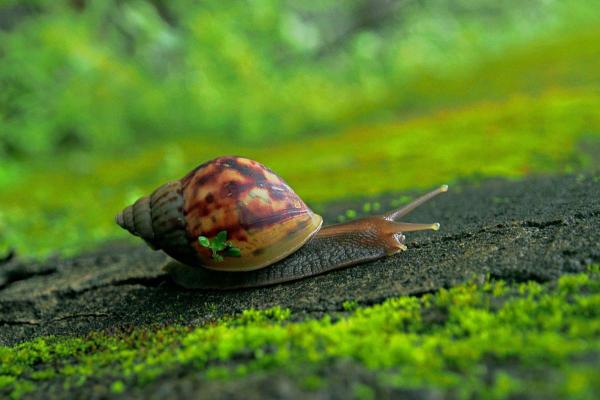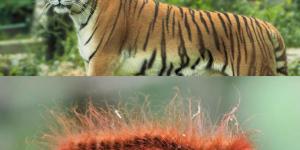Is Snail an Invertebrate?


In the mesmerizing world of the animal kingdom, every creature holds its unique place, characterized by a distinct set of features and evolutionary traits. Among these captivating organisms is the snail, a creature that has intrigued and captivated curious minds for centuries. However, a fundamental question often arises: What exactly is a snail, and to which group does it belong? The answer lies in the realm of taxonomy and the fascinating world of mollusks.
In this AnimalWised article, we delve into the fascinating topic of whether snails belong to the mollusk phylum. We explore their key characteristics and highlight the factors that set them apart from other phyla, such as insects.
Are snails classified as vertebrates or invertebrates?
Snails are classified as invertebrate animals due to their lack of an internal skeleton composed of bones or cartilage.
The classification of invertebrates encompasses the overwhelming majority of animal species on Earth, accounting for around 95% of all known species. This staggering dominance in terms of population highlights the significance of invertebrates in our planet's biodiversity. However, their incredible diversity poses significant challenges in terms of classification and understanding. Countless species within this group await identification and further study, revealing the vast array of undiscovered life forms that exist.
Even our current understanding of known invertebrate species is subject to constant reassessment and revision as new insights and information come to light. The field of invertebrate biology is characterized by its dynamic nature, reflecting the inherent complexity of these organisms and the ongoing process of exploration.
Within the diverse invertebrate group, there is a multitude of variations in anatomy, physiology, reproductive strategies, feeding habits, preferred habitats, defense mechanisms, and behavioral traits. Even among snails, a specific type of invertebrate, distinct characteristics differentiate one species from another.
For example, while the garden snail (Cornu aspersum) thrives in terrestrial environments, the Australian trumpet (Syrinx aruanus) predominantly inhabits marine habitats. Such contrasting traits within the snail species alone exemplify the remarkable diversity that exists and emphasize the intricate nature of invertebrate biology, necessitating ongoing exploration to unravel its intricacies.
You might find this other article interesting, as it explains the major groups of invertebrate animals in detail.
Is the snail categorized as an insect or a mollusk?
The snail and the insect belong to different classifications. While both are invertebrate animals, the snail is classified as a mollusk, whereas insects fall under the phylum Arthropoda. Let's explore the specific features that differentiate snails from insects.
Mollusks
Mollusks, including snails, have distinct characteristics that set them apart:
- They possess a soft body protected by a shell, which is secreted by a specialized tissue called the mantle.
- Snails have a muscular foot that they use for movement, and their body plan consists of a head region, a visceral mass containing their internal organs, and a foot for locomotion.
- They lack articulated legs, a chitinous exoskeleton, and a segmented body like insects.
- Snails also do not undergo metamorphosis, and their eyes are not compound like those of insects. Furthermore, snails do not possess wings for flight.
You might be interested in this other article, where we explain in more detail the different types of mollusks that exist.
Insects
On the other hand, insects have their own unique features:
- They have three pairs of articulated legs, a chitinous exoskeleton, and a segmented body divided into a head, thorax, and abdomen.
- Insects undergo metamorphosis, transitioning through different life stages such as egg, larva, pupa, and adult.
- They often have compound eyes, which are composed of multiple individual visual units, and many insect species possess wings that enable them to fly.
- Insects encompass a wide range of species such as flies, mosquitoes, crickets, butterflies, and grasshoppers, each displaying traits that are vastly different from those found in snails.
Considering these distinctive characteristics, it becomes evident that snails and insects belong to separate groups. By understanding these differences in classification, anatomy, and specific traits, we can appreciate the diversity and uniqueness of both snails and insects as distinct groups within the animal kingdom.
Don't miss out on this other article where we explore the topic of whether insects sleep and delve into how they do so.

What makes a snail a mollusk?
Several distinguishing features make a snail a mollusk:
- Soft body: snails, like all mollusks, have soft bodies without a skeletal or cartilaginous system.
- Mantle and shell: snails possess a mantle, a specialized tissue that secretes a protective shell. The shell is a characteristic feature of many mollusks, including snails. It provides support and serves as a protective covering for the snail's body. The shell can be coiled or non-coiled, depending on the species.
- Radula: snails have a radula, a feeding structure unique to mollusks. The radula consists of numerous tiny, tooth-like structures and is used for scraping or rasping food.
- Circulatory system: snails have an open circulatory system, where the blood flows through vessels and cavities.
- Respiration: snails breathe using either gills or lungs, depending on the species. The respiratory process is closely associated with the mantle.
- Body structure: snails typically have a distinct body structure consisting of a head region, foot for locomotion, and visceral mass containing internal organs.
- Nervous system: snails possess a nervous system composed of ganglia (clusters of nerve cells) connected by nerve cords.
- Sensory organs: snails have various specialized sensory organs, such as tentacles with eyespots, to detect their environment.
- Digestive system: snails have a complex digestive system with enzymes involved in the breakdown of food.
- Feeding habits: snails exhibit a range of feeding habits, including herbivorous, omnivorous, and carnivorous diets, with some species specializing in specific food sources.
- Reproduction: snails can exhibit various reproductive strategies, including hermaphroditism (possessing both male and female reproductive organs) or separate sexes.
These shared characteristics with other mollusks classify snails within the mollusk phylum, specifically in the gastropod class, which includes snails, slugs, and related species.
You might be interested in this other article, where we explain what snails eat.
If you want to read similar articles to Is Snail an Invertebrate?, we recommend you visit our Facts about the animal kingdom category.
- Curtis, H., Barnes, N., Schnek, A., Massarini, A. (2008). biology . Panamerican Medical Editorial. Madrid.
- Hickman, C., Roberts, L., Parson A. (2000). Comprehensive principles of zoology . McGraw Hill Inter-American: Spain.






